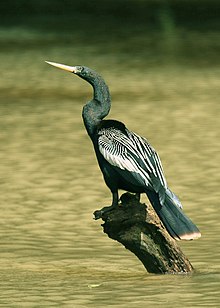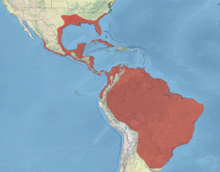Hi Everybody!!
*(Special Note to my real-time friends: Sorry to be late with my post and Yes, I fell asleep at my desk! I was having my FIRST measured rainfall of April 2013- Anyway, a couple of years ago, my 84yr old cousin in Houston, called me up and filed a complaint that he did not have his blog for his coffee! I explained that I was not the Houston Chronicle, I was just me, his cuz, and I do not have a complaint department! He informed me not to let it happen again and hung up! So, to my friends on the other side of the world who are having coffee: Sorry!) To anybody else coming by in the future: Anytime you arrive here will be the Right Time!
Welcome to Rainbow Creek!
CATCH OF THE DAY: SNAKEBIRD
I was hiking through the woods to the wide part of Rainbow Creek to see if any Spring Migration Birds had arrived yet. Bird Migration is divided into two time zones now. One is before BP, the other is after BP. Before BP there were thousands of water birds here as you can see in my Picasa Web Albums or G+Photo Albums. There have not been any, as in not one single bird, after BP. Out of habit, I am compelled to go look!
You never now what You Might See
On this day, rain was strongly indicated and cloud cover was suffocating, then presto, like magic, the clouds opened up and went away. Hooray, a magic sunny afternoon. With the anticipation of a child, I went running through the woods, down the creek in search of the gold at the end of the Rainbow. When I got to where I could see the water, my trained eyes quickly scanned the top of the water for any prize. Suddenly a flicker of light across the way, but in the dimming light and distance away, I could not tell what it was. I increased my pace and got halfway to the shore. I saw a big and golden light moving, but could not identify anything. Like the old granny that I am, I forgot the binoculars. I only had the camera because it was attached to my neck! This was out of range of my camera, but I zoomed in anyway hoping to identify what bird it must be. Whatever it is, It is big. These are the shots before he flew:
Even when I got this close, I had no idea what I was seeing!
He looked like a huge snake with wings!
He Takes Off in black and white
CHAPTER 2
Finally, I made it to here the shore. He is directly across the way in the shadow indention to the left of center. He flew into a tree not being lit by the setting sun. These are what I got:
A Snake with Feathers:
I had no idea what bird this is, but he is among the King of Kings of his tribe. You know by now who knew-----Google Knew!
Google Index to the Rescue in Bird Identification!
Google You Tube to the Rescue with vids of the Snakebird!
(disclaimer: I do not work for Google or Receive any $ from Google. They do not currently have a position available for birdbrains! I am hoping for a personal computer electric car to be delivered, it is probably in the mail).
From the Google Index:
http://en.wikipedia.org/wiki/Anhinga
Anhinga
From Wikipedia, the free encyclopedia
The Anhinga (Anhinga anhinga), sometimes called Snakebird, Darter, American Darter, or Water Turkey, is a water bird of the warmer parts of the Americas. The word anhinga comes from the Brazilian Tupi language and means devil bird or snake bird.
It is a cormorant-like bird with an average body length of 85 cm (33 in), a wingspan of 117 cm (46 in), and a mass of up to 1.35 kg (3.0 lb). It is a dark-plumaged piscivore with a very long neck, and often swims with only the neck above water. When swimming in this style the name Snakebird is apparent, since only the colored neck appears above water the bird looks like a snake ready to strike. They do not have external nares (nostrils) and breath solely through their epiglottis.
The Anhinga is placed in the darter family, Anhingidae, and is closely related to Indian (Anhinga melanogaster),African (A. rufa), and Australian (A. novaehollandiae) Darters.
| Anhinga | |
|---|---|
 | |
| Male in Costa Rica | |
 | |
| Female in Florida, USA | |
| Conservation status | |
| Scientific classification | |
| Kingdom: | Animalia |
| Phylum: | Chordata |
| Class: | Aves |
| Order: | Suliformes |
| Family: | Anhingidae |
| Genus: | Anhinga |
| Species: | A. anhinga |
| Binomial name | |
| Anhinga anhinga (Linnaeus, 1766) | |
| Subspecies | |
A. a. anhinga
A. a. leucogaster | |
 | |
| Distribution map. Brighter red indicates breeding only range. | |
Distribution and migration
Anhinga species are found all over the world in warm shallow waters.[2]The American Anhinga has been subdivided into two subspecies, A. a. anhinga and A. a. leucogaster, based on their location. A. a. anhingacan be found mainly east of the Andes in South America and also the islands of Trinidad and Tobago. A. a. leucogaster can be found in the southern United States, Mexico, Cuba, and Grenada.[3]
Only birds that do not live in the extreme north and south of their range migrate and do so based on temperature and available sunlight. Anhingas will migrate towards the equator during winter but this range is "determined by the amount of sunshine to warm the chilled birds".[2]Although not in their usual range, anhingas have been found as far north as the states of Pennsylvania[4] and Wisconsin[5] in the United States.
Kettles of anhingas often migrate with other birds and have been described as resembling black paper gliders.[6]
[edit]Physical description and taxonomy
The A. anhinga species is a large bird and measures approximately 89 cm (35 in) in length, with a range of 75–95 cm (30–37 in), with a 1.14 m (3.7 ft) wingspan.[7][8] The A. a. anhinga subspecies is larger than A. a. leucogaster and has "broader buffy tail lips".[3] They weigh on average around 1.22 kg (2.7 lb), with a range of 1.04–1.35 kg (2.3–3.0 lb).[8][9][10] The bill is relatively long[5] (about twice the length of the head[11]), sharply pointed[7] and yellow as are the webbed[9] feet.
Most of the male Anhinga's body is a glossy black green with the wings, base of wings, and tail being a glossy black blue.[11] The tip of the tail has white feathers.[12] The back of the head and the neck have elongated feathers that have been described as gray[13] or light purple white.[11] The upper back of the body and wings is spotted or streaked with white.[13]
The female Anhinga is similar to the male Anhinga except that it has a pale gray-buff[14] or light brown[15] head, neck, and upper chest. The lower chest or breast is a chestnut color and as compared to the male, the female has a more brown back.[16]
The hatchling starts out bald but gains tan down within a few days of hatching. Within two weeks the tan down has been replaced by white down. Three weeks after hatching, the first juvenile feathers appear. Juveniles are mostly brown until first breeding after the second or third winter.[2]
This bird is often mistaken for the Double-crested Cormorant due to its similar size and behavior. However, the two species can be differentiated by their tails and bills. The tail of the anhinga is wider and much longer than that of the cormorant. The bill of the anhinga is pointed, while the bill of the cormorant has a hook-tip.[17]
Behaviour
Unlike ducks, the Anhinga is not able to waterproof its feathers using oil produced by the uropygial gland. Consequently, feathers can become waterlogged, making the bird barely buoyant. However, this allows it to dive easily and search for underwater prey, such as fish and amphibians. It can stay down for significant periods.
When necessary, the Anhinga will dry out its wings and feathers, with the resemblance of the semicircular full-spread shape of its group of tail feathers while drying them out, to that of true meleagrine males lending the name "water turkey" to it. It will perch for long periods with its wings spread to allow the drying process, as do cormorants. If it attempts to fly while its wings are wet, it has great difficulty getting off the water and takes off by flapping vigorously while "running" on the water.
Anhinga will often search for food in small groups.
[edit]Conservation status
The Anhinga is protected in the US under the Migratory Bird Treaty Act of 1918.[18] The number of individual anhingas has not been estimated but they are considered to be of least concern because of the frequency of their occurrence in their 15,000,000 km2 (5,800,000 sq mi) global range.[1]****************************************
FEATURE PRESENTATION:
Video Lineup from Google You Tube Site:
http://www.youtube.com/watch?v=FJtF4VvKBTA
http://www.youtube.com/watch?v=qj3NV3B-nIA
http://www.youtube.com/watch?v=EfoqPIcSQCQ
http://www.youtube.com/watch?v=i_EhBW-8u
...this is brendasue signing off from Rainbow Creek. See You next time. Now Fly Away with your one more great performance!
http://www.youtube.com/watch?v=NtkY3ekMpKc
O+O


























No comments:
Post a Comment
Hi Everybody! Please say hello and follow so I know you are here! Due to the inconsideration of people trying to put commercials on my blog comment area, I have restricted use of anonymous posts. Sorry that some hurt all.
My public email is katescabin@gmail.com No spammers or trolls